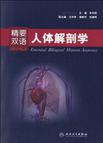精要双语人体解剖学
出版时间:2010-1 出版社:人民卫生出版社 作者:车向新 编 页数:287
前言
随着我国对外交流的日益增多以及医药科技的迅速发展,专业英语在医药相关人员学习与工作中的重要性日益受到重视。教育部在《关于加强高等学校本科教学工作,提高教学质量的若干意见》中提出:“为适应经济全球化和科技革命的挑战,本科教育中要创造条件使用英语等外文进行公共课和专业课教学”。人体解剖学是重要的基础医学课程之一,人体解剖学名词构成医学名词的重要组成部分。目前,国内近1/3的高等医药院校开设了人体解剖学课程的英汉双语教学或全英文教学;同时,许多院校还招收了来自东南亚地区的留学生学习医学。根据笔者的教学体会及对学生的调查,发现在人体解剖学课程双语或全英文教学中,学生对解剖学基本知识点的理解与掌握难以达到预期的目标。正是基于以上原因,本人于五年前开始组织编写“Essential Bilingual Human Anatomy”《精要双语人体解剖学》。 为满足广大读者的需求,在人民卫生出版社的大力支持下,由六所高等医药院校长期从事人体解剖学教学的专家编写了这本《精要双语人体解剖学》。本书可供基础医学、临床医学、口腔医学、麻醉学、医学影像学、护理学等专业的本科生、研究生和留学生使用,也可为医学院校教学人员和临床医护人员参考。 为有助于读者对英汉双语教学或英语教学内容的学习与理解,本书在内容编排和形式上有以下特点: 1.将人体按头部、颈部、胸部、腹部、盆部、背部、上肢与下肢的顺序编排,每个部分又分为若干个相对独立又相互联系的单元。 2.将系统解剖和局部解剖知识结合到每个单元内,如:腹壁相关的骨骼肌、动脉供应、静脉淋巴回流、神经支配、局部结构等,自成体系,突出英文描述。
内容概要
本书可供基础医学、临床医学、口腔医学、麻醉学、医学影像学、护理学等专业的本科生、研究生和留学生使用,也可为医学院校教学人员和临床医护人员参考。 本书将人体按头部、颈部、胸部、腹部、盆部、背部、上肢与下肢的顺序编排,每个部分又分为若干个相对独立又相互联系的单元。将系统解剖和局部解剖知识结合到每个单元内,如:腹壁相关的骨骼肌、动脉供应、静脉淋巴回流、神经支配、局部结构等,自成体系,突出英文描述。每个单元内的骨骼肌、神经、脉管等,分别根据其各自特性进行英文解释。每个单元后简要介绍了临床常见病、多发病的概念,以及公认的诊疗技术与手段,与每个单元的内容相呼应。书末附有英汉索引,便于读者查阅。充分体现了科学性、系统性、创新性与实用性。
书籍目录
Introduction1.Head&Neck头部与颈部 1.1 AnteriorTriangle ofthe Neck颈前三角 1.2 Posterior Triangle ofthe Neck颈后三角 1.3 Skull&Brain颅与脑 1.4 Carotid Sheath,Pharynx&Larynx颈动脉鞘、咽与喉 1.5 Face面部 1.6 Infratemporal Fossa颞下窝 1.7 Submandibular Region,Nasal&Oral Cavities下颌下区、鼻腔与口腔 1.8 Ear耳 1.9 Eye眼2.Thorax胸部 2.1 Pectoral Region胸区 2.2 Thoracic Wall,Pleura&Pericardium胸壁、胸膜与心包 2.3 Heart心脏 2.4 Lungs&Superior Mediastinum肺、上纵隔 2.5 PosteriorMediastinum后纵隔3.Abdomen腹部 3.1 Abdominal Wan腹壁 3.2 Inguinal Region腹股沟区 3.3 Peritoneal Cavity&Intestines腹膜腔与肠 3.4 Stomach&Spleen胃、脾 3.5 Duodenum,Pancreas,Liver&Biliary System十二指肠、胰、肝与胆道系统 3.6 Kidneys&Retroperitoneum肾与腹膜后区4.Pelvis盆部 4.1 Pelvis Cavity and Its Coments盆腔及其内容 4.2 Pelvic Wall&Floor骨盆壁与骨盆底 4.3 Perineum&External Genitalia会阴与外生殖器5.Back背部 5.1 Superficial Back背部浅层 5.2 Deep Back&Spinal Cord背部深层、脊髓6.Lower Limb下肢 6.1 Superficial Structures of the Lower Limb下肢浅层结构 6.2 Anterior&MedialThigh股前区与股内侧区 6.3 Hip&PosteriorThigh臀区与股后区 6.4 Leg小腿 6.5 Foot足 6.6 Joints ofLower Limb下肢的连结7.Upper Limb上肢 7.1 Shoulder&Superficial Upper Limb肩与上肢浅层 7.2 Axilla,Arm&Cubital Fossa腋窝、手臂与肘窝 7.3 Forearm&Wrist前臂与手腕 7.4 Hand手 7.5 Joints ofthe Upper Limb上肢的连结Indexs
章节摘录
Nerves that exit directly from the brain are said to be cranial nerves.Nerves that exit directly from the spinal cord are said to be spinal nerves. The PNS consists of the cranial and spinal nerves (with their branches) and that part of theautonomic nervous system ( 自主神经系统) associated with spinal nerves. A detailed consideration of brain and spinal cord structure is the province of neuro-anatomists. Gross anatomists are concerned with the PNS. An understanding of the innervationof specific organs is one of the most clinically important tasks facing a student of medicine. 2. Efferent versus Afferent, Motor Versus Sensory The difference between the efferent and afferent, or motor and sensory, portions of thenervous system is defined functionally. Any nerve fiber that carries information from the CNSout to other tissues of the body is defined as an efferent fiber (传出纤维), and along with its cellbody it constitutes an efferent neuron. Any nerve fiber that carries information from other tissuesof the body into the CNS is defined as an afferent fiber (传入纤维), and along with its cell bodyit constitutes an afferent neuron. Most efferent neurons are concerned with innervating glandsand muscles-the motor tissues of the body. This large subset of efferent neurons comprises themotor (运动) portion of the peripheral nervous system. Most afferent information coming intothe CNS is capable of reaching consciousness. Touch, temperature, pressure, vibration, stretch,and pain are sensory modalities familiar to all of us. The large subset of afferent neurons carryinginformation that can reach consciousness comprises the sensory (感觉)part of the peripheralnervous system. 3. Visceral Versus Somatic Neurons Among the motor tissues of the body a major distinction can be made between striatedvoluntary muscle, on the one hand, and smooth muscle, cardiac muscle, and glands, on the other.Striated voluntary muscle composes the so-called somatic motor tissue of the body. Smoothmuscle, cardiac muscle, and glands constitute the visceral motor tissue. More generally, anydissectible structure formed largely of visceral motor tissue is said to be a visceral structure.All other structures, whether formed of striated voluntary muscle or simply connective tissue,are said to be somatic structures. Most of the body wall is composed of somatic structures,only its vasculature, arrector pili muscles, sweat glands, and sebaceous glands being visceral.On the other hand, all the internal organs of the body are visceral structures. Nerve fibers thatstimulate striated muscle tissue are said to be somatic motor fibers (身体运动纤维).
图书封面
评论、评分、阅读与下载
用户评论 (总计2条)
- **书一本。
- 这本书一点用都没有,而且价格还很贵,不建议买,买了也没有用。
相关图书
- 乳腺病理学
- 高考文科综合考大练兵高考文科综合能力测试题解析附模拟题
- 医疗损害赔偿纠纷
- 女人一生的抗衰养生计划
- 维权与信访法律知识问答
- 生物化学
- Flags Sticker Book [With Stickers] (平装)
- 英语高分秘诀:语音及语法/初中非常系列
- 徐州交通史
- 中考历史考纲例释与能力测试--挑战名牌高中
- 中国高中生文学鉴赏胜经/黄金阅读
- 高中文言文同步解.译.练第三册(供二年级上学期使用)//名师文言课堂
- 现代田径运动实用指南
- 中考生物考纲例释与能力测试--挑战名牌高中
- 英语高分秘诀--词汇/初中非常系列
- 老毕业证书
- 医疗法律操作小全书
- (英语)最后一卷//中考模拟试卷集
- 工程机械电器与电子控制装置
- 中考政治考纲例释与能力测试--挑战名牌高中
- 黄金背诵(初中版)-古诗词推荐篇目//初中语文新大纲
- 上海桑塔纳轿车构造.使用与维修
- 高考语文考纲例释与能力测试--挑战名牌大学
- 基础会计学习指导与模拟实训
- 中国初中生记叙文阅读胜经
